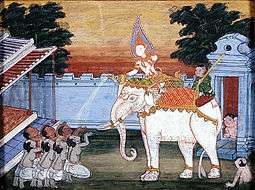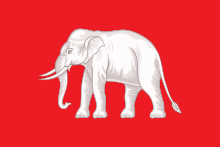White elephant (animal)

A white elephant (also albino elephant) is a rare kind of elephant, but not a distinct species. Although often depicted as snow white, their skin is normally a soft reddish-brown, turning a light pink when wet.[1] They have fair eyelashes and toenails. The traditional "white elephant" is commonly misunderstood as being albino, but the Thai term chang samkhan, actually translates as 'auspicious elephant', being "white" in terms of an aspect of purity.[2]
White elephants are only nominally white. Of those currently kept by the Burmese rulers—General Than Shwe regards himself as the heir of the Burmese kings—one is grey and the other three are pinkish, but all are officially white. The king of Thailand also keeps a number of white elephants. Former U.S. Vice President Spiro Agnew once presented a white elephant to King Norodom Sihanouk of Cambodia.
Hinduism

The white elephant is considered to belong to the god Indra. The name of the elephant is Airavata and it is a flying elephant. Airavata is made the King of all elephants by Lord Indra.
King Bimbisara had one such white elephant, which he had captured in a forest when the elephant was in his Musth period. He named the bull elephant Sechanaka which means "watering" as the elephant used to water the plants by himself without any prior training. It is said the cost of this elephant was more the half of Magadha. He later gave it to his son Vihallakumara, which made his other son Ajatashatru jealous. Ajatashatru tried to steal it many times, which resulted in two of the most terrible wars called the Mahasilakantaka & Ratha-musala. (see Ajatashatru).
Thailand

"According to Brahmanic belief, if a monarch possessed one or more 'white' elephants, it was a glorious and happy sign." King Trailok possessed the first. In the Thai language, they are called albino, not white, indicating "pale yellow eyes and white nails", with white hair. The "rough skin was either pink all over or had pink patches on the head, trunk, or forelegs." "They were not worshipped for themselves and were regarded as an appendage to the King's majesty."[3]:39
In Thailand, white elephants (ช้างเผือก, chang phueak) (also known as Pink Elephants) are considered sacred and are a symbol of royal power; all those discovered are presented to the king (although this presentation is usually a ceremonial one—the elephants are not actually taken into captivity). Historically, the status of kings has been evaluated by the number of white elephants in their possession. The last king, Bhumibol Adulyadej, owned ten—considered a great achievement, and probably due to modern communications. All ten have since died, and there is no evidence of any white elephants currently living in Thailand. The last white elephant of the King died in 2006.
A white elephant in Thailand is not necessarily albino, although it must have pale skin. After being discovered, the elephants are assigned to one of four graded categories before being offered to the king, although the lower grades are sometimes refused.
In the past, lower grade white elephants were given as gifts to the king's friends and allies. The animals needed a lot of care and, being sacred, could not be put to work, so were a great financial burden on the recipient - only the monarch and the very rich could afford them. According to one story, white elephants were sometimes given as a present to some enemy (often a lesser noble with whom the king was displeased). The unfortunate recipient, unable to make any profit from it, and obliged to take care of it, would suffer bankruptcy and ruin.[4]
Burma
In Burma as well, white elephants have been revered symbols of power and good fortune. The announcement by the ruling military regime of the finding of white elephants in 2001[5] and 2002[6] was seen by opponents as being aimed at bolstering support for their regime. As of 2010 Burma has total nine white elephant (as of February 2014). The last white elephants was found in Basein area of southern Burma on 27 February 2015. Three white elephants are currently held[7] in a pavilion on the outskirts of Yangon. The rest are kept at Nay Pyi Daw, the new Burmese capital.
Africa

| Wikinews has related news: Pink elephant spotted in Botswana |
Albinos are much more rare among African elephants than in Asia. They are reddish-brown or pink, and may suffer blindness or skin problems from sun exposure.[8]
Western cultural references
In English, the term "white elephant" has come to mean a spectacular and prestigious thing that is more trouble than it is worth, or has outlived its usefulness to the person who has it. While the item may be useful to others, its current owner would usually be glad to be rid of it.
See also
- Abul-Abbas, a (possibly) white elephant given to Charlemagne by Harun al-Rashid
- Airavata, a white elephant whom the god Indra rides
- Hanno (elephant), the pet of Pope Leo X
- Seeing pink elephants, a euphemistic term for visual hallucination arising from alcohol intoxication
- White elephant gift exchange, a popular winter holiday party game in the U.S.
References
| Wikimedia Commons has media related to White elephants. |
- ↑ Men ride albino elephants, Reuters via The Atlantic, 1 March 2012.
- ↑ "Royal Elephant Stable". Thai Elephant Conservation Center. Retrieved 7 September 2014.
- ↑ Chakrabongse, C., 1960, Lords of Life, London: Alvin Redman Limited
- ↑ "Home : Oxford English Dictionary". Oed.com. Retrieved 2013-01-07.
- ↑ 'Lucky' white elephant for Burma, BBC, 9 November 2001.
- ↑ Second White Elephant Found at the Wayback Machine (archived June 23, 2002)
- ↑ White Elephants Snubbed by Junta at the Wayback Machine (archived June 6, 2011)
- ↑ Rebecca Morelle. Pink elephant is caught on camera, BBC News, 20 March 2009
External links
- "Royal Elephant Stables". Thai Elephant Conservation Center. – Story and history of Royal White Elephants
- The Royal White Elephants, 2002, Mahidol University
